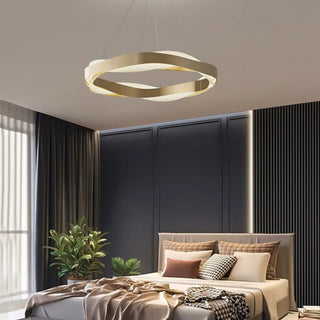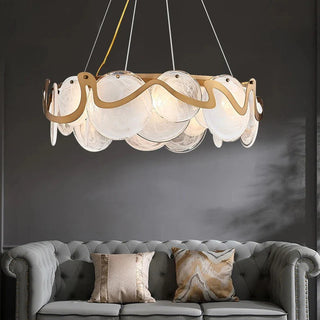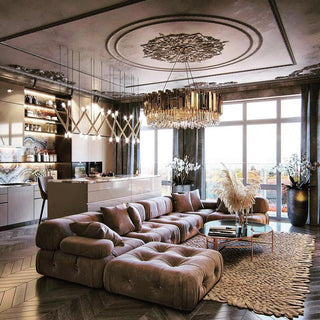Zoning is a decorative technique that visually divides the space into separate functional zones. The main classic zones in country houses and modern apartments are the entrance hall and living room, bedroom, children's room, study, dining room, kitchen, and bathroom. Each zone has its functional purpose and requires its own lighting. Various types of chandeliers and lamps allow you to give each zone its own image and design.
One of the most effective ways of zoning the space in a room is lighting. With the help of light, it is possible not only to highlight functional zones in the room but also to focus on individual objects and interior elements. Zoning the space with light includes using natural and artificial light. Artificial lighting of the room can be general (upper), local and decorative. With the help of general lighting fixtures, illumination of the entire space is achieved due to evenly diffused light. For general lighting, in most cases, suspended and ceiling chandeliers are used. We often use local lighting to pay attention to the decoration, color scheme, texture of the surface of the walls, ceiling, floor, furniture, and other interior elements of the room. Local lighting helps create comfortable conditions for work, rest, and sleep. For local lighting, designers use wall sconces, wall and ceiling spots, table lamps, floor lamps, and LED strips.
Chandeliers and other kinds of lamps should fit well into the interior and form a harmonious unity with other interior items. It is much more difficult to solve the issues of zoning with the help of lighting in apartments and houses of traditional layout, where it is sometimes necessary to experiment and be creative with lighting device installation.
Basic techniques of zoning using light. Let's consider the basic techniques of zoning space with light. First of all, there is never too much light, and it is better to make an extra light source that you will not use than to forget an important one and leave an area without proper lighting. When planning repairs, do not neglect sockets. That way you can always deliver a floor lamp or a table lamp, zoning the right space with them.
Highlighting areas by low suspension lamps
In most cases, designers use this method to highlight dining tables and the beds in the bedroom. In the latter case, two small hanging chandeliers can completely replace standard sconces or lamps on bedside tables. That way the bedroom lighting is softer, and the design of the room is modern and original.
Above dining tables, there are more often three hanging lamps there. They not only illuminate the table itself but also clearly separate it from the rest of the room, creating a nice atmosphere when the other light sources are turned off.

Directional light above the work surface
Local lamps with directional light have a similar effect: LEDs on the kitchen apron, table lamps, floor lamps, and sconces. When switched on, they isolate a work area, for example, a desk or a kitchen countertop, from the space around or gently designate a relaxation area – an armchair with a dim light of a floor lamp, and a bedside table.

Warm and cold light combination
Cold light is always bright and is ideal for work – writing, reading, cooking. Warm light, on the other hand, creates comfort, relaxes, and encourages rest. In any room, it is better to combine cold and warm lighting, thereby highlighting work areas and recreation areas. Most often, one or two small zones are emphasized with cold light, including using it as an interior accent. The main lighting in the living room should always be warm. Also, the warm spectrum of light visually makes a room with dark walls more spacious.
Using natural light
The sun should also be considered as an additional light source. Sunny rooms always look more airy and positive. Living rooms, kitchens, and children's rooms should be very open and sunny. In these rooms, it is better not to use bulky, heavy curtains and try to remove all unnecessary items from the window sills. Put a sofa, an armchair, or a dining table closer to the window so that they are highlighted by sunlight and separate this space from the rest of the zones.
As we mentioned before, the living room needs bright enough lighting. For this purpose, it is appropriate to install a chandelier, which is most often installed in the center of the ceiling. If the living room area is large enough, then you can shift the chandelier from the center. Wall sconces over a coffee table, a table lamp, or a floor lamp will be appropriate in the lounge corner of the living room.

Bedroom lighting should create comfortable conditions for sleeping and relax after a hard day. Both general and local lighting can be arranged in the bedroom. If the bedroom is small, you can abandon the general (upper) lighting in favor of local lighting and install sconces on both sides above the bed. The ideal option for creating comfortable bedroom lighting is wall spots, which will allow you to direct the light to the right place and at a certain angle. It is also possible to install table lamps on bedside tables. You can also install sconces on both sides of the dressing table with a mirror.

Kitchen is a place where there are also separate zones (cooking or dining zones, for example), each of which requires its own lighting. General kitchen lighting can be arranged using a chandelier, ceiling lamp, or hanging lamp. Height-adjustable single-lamp pendant lamps look very impressive in the dining area. Their number depends on the length of the dining table, maybe two or three. The light coming from the lamps creates diffuse lighting. In the food processing and cooking area, you can install spotlights. They make the room look modern and stylish.






